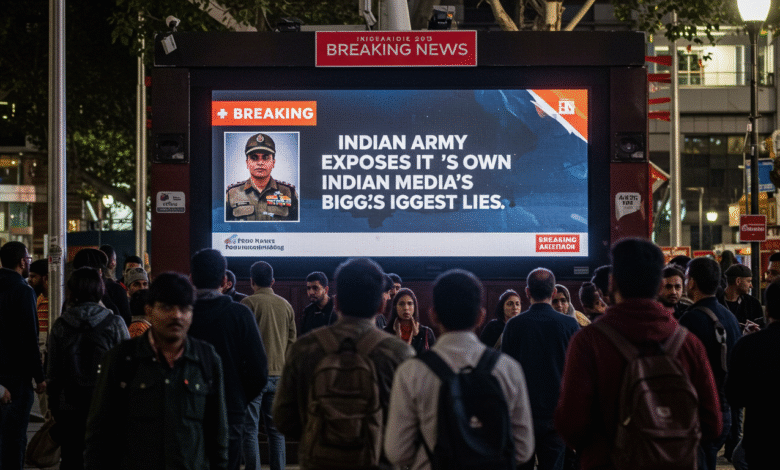Indian Army Exposes Its Own Indian Media’s Biggest Lies

In a democracy, the media is expected to act as the fourth pillar—objective, reliable, and transparent. But what happens when this pillar crumbles under the weight of sensationalism, political pressure, and corporate influence? In recent years, India has witnessed an unprecedented rise in misinformation and jingoistic propaganda, especially when it concerns national security and the armed forces.You know about theglobespot, andaazdaily, openrendz and indian army exposes media lies also Buzzfeed.
Surprisingly, the Indian Army—often considered above politics—has started pushing back. In a rare move, military officials and veterans have exposed some of the most sensationalized and misleading narratives pushed by mainstream Indian media outlets.
This article dives deep into these revelations, examining how and why the Indian Army chose to counter its own media’s fabricated stories.
The Rise of Hyper-Nationalist Media in India
TRP Over Truth
Indian news channels today are engaged in a constant battle for Television Rating Points (TRPs). This competition has given rise to a disturbing trend: prioritizing dramatic and emotional storytelling over verified facts. Many prime-time debates resemble wrestling matches more than actual journalism.
Channels regularly run war-mongering content, especially after border skirmishes. Headlines scream “Enemy Killed,” “Surgical Strike 2.0,” and “PAK Crushed Again,” even when no such military operations occurred.You know about theglobespot, andaazdaily, openrendz and indian army exposes media lies also Buzzfeed.
The Army in the Crossfire
While the Indian Army has always respected media freedom, the relationship has become increasingly strained. Sensationalist headlines not only distort facts but also endanger lives. Fake reports about troop movements, planned operations, and “massive retaliations” often force the Army to go on damage control.
High-Profile Cases Where Lies Were Exposed
Case 1: The Balakot Airstrikes
In 2019, following the Pulwama attack, the Indian Air Force conducted airstrikes in Balakot, Pakistan. Indian media quickly declared over 300 terrorists killed. However, international satellite images and reports questioned this figure.
The Indian government maintained strategic silence, but Indian Army officials, off the record, confirmed that the actual damage was “strategic, not numerical.” This indirect refutation highlighted the media’s exaggerated claims.You know about theglobespot, andaazdaily, openrendz and indian army exposes media lies also Buzzfeed.
Case 2: Surgical Strikes and Doctored Videos
After the 2016 Uri attack, India claimed to have carried out “surgical strikes” on terror camps across the Line of Control. Media channels showcased supposed “leaked footage” of the strikes. Later, it emerged that some of this footage was unrelated—either from training exercises or simulated war games.
When questioned, a senior Army source confirmed, “Some of the visuals being circulated have no connection with the real operation.”
Case 3: The Galwan Valley Clashes
During the 2020 standoff with China, Indian media repeatedly claimed massive Chinese casualties. Numbers ranged from 40 to 100 dead PLA soldiers. Indian Army sources, however, maintained that the situation was delicate and misinformation could hamper diplomacy.
Later, the Indian Army officially clarified that no firearms were used and that both sides suffered casualties, but Indian media’s casualty figures were never verified.
Why the Indian Army Decided to Speak Up
Maintaining Operational Secrecy
One major concern is operational security. Sensational reporting can leak sensitive troop movements or strategies. In a few instances, journalists eager for exclusives published sensitive data that could have put soldiers at risk.
Protecting Troop Morale
Inflated claims may sound patriotic but can demoralize soldiers. If false claims of victories are later debunked, it reflects poorly on the forces. Soldiers operate in harsh conditions and deserve truthful reporting—not clickbait.
Diplomacy at Risk
Incorrect media reports can inflame tensions with neighboring countries. India’s military strategies often involve backchannel diplomacy. Misreporting can derail negotiations and make India appear aggressive even when pursuing peaceful resolutions.
Inside Sources Speak Out
Anonymous Army Officers Talk
Several serving and retired officers, under anonymity, have voiced concerns about the media’s role in misrepresenting facts.
“We understand the need for national pride. But blind nationalism can be as dangerous as enemy bullets,” said a colonel involved in counter-terror operations.
“Many times, we’ve had to issue internal advisories urging units not to interact with the media. We can’t afford a leak that could cost lives,” shared another officer posted in Ladakh.
Media’s Response: Denial or Deflection?
Playing the Victim Card
When confronted, many media houses claim they’re being targeted for being “nationalist.” They accuse critics of being “anti-India.” This victim narrative allows them to deflect criticism without accountability.
Lack of Accountability Mechanisms
India’s media regulation remains weak. Bodies like the Press Council of India lack enforcement power. TV channels often go unpunished even when caught spreading fake news.
The Role of Social Media and WhatsApp University
Echo Chambers and Amplification
Even if TV channels are restrained, their content is widely shared on WhatsApp, Facebook, and X (formerly Twitter). Once a fake story is published, it spreads like wildfire. Debunking the falsehood rarely receives equal attention.
Army’s Cyber Unit Steps In
The Army’s Information Warfare Division now tracks social media for fake news that could affect military operations. Several false narratives have been flagged and removed from platforms.
Prominent Lies Busted by the Army or Defense Ministry
“Pakistan Flag on Red Fort”
During farmer protests in 2021, some media channels claimed a protestor waved the Pakistani flag at Red Fort. Later, it was proven to be the Nishan Sahib—a Sikh religious flag. Military veterans condemned the misinformation, calling it “divisive and dangerous.”
“Pakistan Army Uniforms Found in Kashmir”
Channels once ran stories showing alleged Pakistani Army uniforms recovered in Kashmir. Defense sources clarified these were fabricated stories used to stir up anti-Pakistan sentiment without evidence.
“Chinese Village Built Inside Indian Territory”
During the 2021 border tensions, reports claimed China built a village inside Indian territory. Satellite imagery later showed that the area was within Chinese-claimed land since the 1950s. The Army clarified but the misinformation had already gone viral.
Voices of Reason: Veterans and Journalists Push Back
General H. S. Panag (Retd.)
A former Northern Army Commander, Gen Panag has been vocal about media misinformation. He regularly calls out jingoism and urges for strategic, informed discussions.
Ajai Shukla, Defense Analyst
Shukla has exposed multiple media lies regarding defense matters. He argues that a healthy democracy requires transparency and that “patriotism should never mean distorting the truth.”
Consequences of Media Lies
Domestic Division
Exaggerated reporting has increased communal and political tensions. Narratives are often tailored to favor one political ideology over another, using the Army as a prop.
International Embarrassment
False reports cited in global media damage India’s credibility. When Indian media’s fake news is debunked internationally, it reflects poorly on both the press and the government.
Distrust Among Soldiers
Veterans reveal that soldiers often feel frustrated by media headlines that do not match ground reality. This trust deficit can affect morale.
The Way Forward: What Needs to Change
Fact-Checking as a Norm
Major news outlets must establish independent fact-checking desks. Stories related to national security must be double-verified before airing.
Military-Media Protocols
A formal military-media interaction protocol could reduce misinformation. Scheduled briefings, similar to those in the US and UK, would offer accurate updates.
Educating the Audience
Media literacy must be promoted. Citizens should be taught how to differentiate between propaganda and credible reporting.
Conclusion
The Indian Army exposing lies propagated by Indian media is not just an indictment of journalism but a wake-up call for democratic accountability. When the guardians of our borders are forced to fact-check the guardians of our information, it signals a deep rot.
India deserves a media landscape where facts outweigh fiction and truth triumphs over TRPs. The Army’s decision to speak up may seem unusual, but in an age of misinformation, silence is no longer an option.



